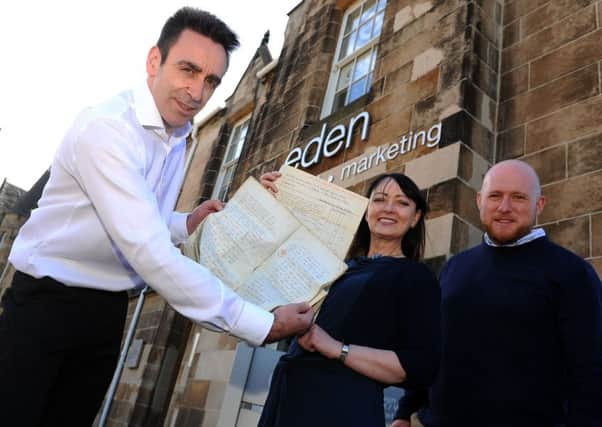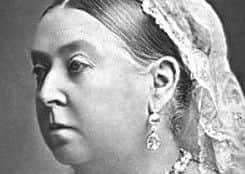Hope Street ‘time capsule’ reveals its secrets after 175 years


Currently home to thoroughly modern Eden Design, its curious internal layout possibly justifies the word “Dickensian”, because it was built when that famous early-Victorian wordsmith was in his heyday.
But what has really excited the imagination of Eden Design managing director Douglas Cameron is the astonishing treasure trove of historic documents he and his staff have uncovered.
Advertisement
Hide AdAdvertisement
Hide AdThey include original deeds, architects’ plans, hand-written quotations in copperplate script, letters and legal papers - a time capsule of old Falkirk whose importance has never been fully grasped until now.


Douglas says: “It’s a virtually intact set of records dating back to 1832 - a fascinating insight into the people and the events that took place since the building was constructed in 1845.
“It includes its role (from 1900 until 2008) as the base for Falkirk solicitors John and WK Gair and Gibson, when John William Gibson acquired it in March 1900 after the original owner’s estate was wound up”.
To put it all in perspective, the building - much older than previously thought - was probably built as a townhouse in 1845.
Advertisement
Hide AdAdvertisement
Hide AdThat was the year when the USA formally annexed Texas, taken from the Mexicans in the 1830’s after the campaign which followed the famous last stand at the Alamo - where the Texan insurgents had used cannon from the Carron Iron Works.
It was when a British expedition to find the Northwest Passage ended in utter disaster - and cannibalism - while in wars abroad Britain’s East India Company fought the Sikh state in the Punjab, and Britain waged war on the Maoris in New Zealand.
Closer to home, it was the year which saw the outbreak of the Great Famine in Ireland, an avoidable human disaster of unimaginable horror. Some estimates put the death toll at a million, while two million were forced to emigrate.
In that very year, as an endless procession of boats dangerously overladen with starving Irish refugees limped uncertainly up the Clyde, the first owner of the Hope Street building - Irishman Peter Feely - was about to move in.
Advertisement
Hide AdAdvertisement
Hide AdAmid these seismic national and international events Falkirk quietly bloomed as a success story of the Industrial Revolution - and the local lawyers, architects and other professionals of their day left a written trail of their business dealings at Number 4 Hope Street.
The records date as far back to 1832, year of the Great Reform Act (which finally set a course for modern parliamentary democracy), but even the more recent documents offer a fascinating insight into the commercial and professional life of Falkirk’s Victorian past.
Douglas, who is looked forward to a visit from Historic Environment Scotland, said: “Pouring over these documents has been a bit like the recent BBC2 programme ‘A House Through Time’.
“It’s even more fascinating because the people involved were Falkirk Bairns, who lived and worked right here in this building in Hope Street”.
Advertisement
Hide AdAdvertisement
Hide AdOriginal owner Peter Feeley, meanwhile, must have become one of Falkirk’s more influential citizens.
Douglas said: “We know quite a lot about Mr Feely, including that he was a close acquaintance of the then Falkirk based Burgh Architect Alexander Black, and of both Reverend Andrew Caruthers, the Roman Catholic Bishop, plus Reverend Paul McLachlan, who set up the Catholic Church in Falkirk in the 1840’s.
“From what might have been a fairly humble early life in Ireland, Peter Feely appears to have gone on not only to construct our building in Hope Street - he also owned ships and other property in Grangemouth Old Town and in Kirkintilloch.
“He played an important part in the birth of the railways in this part of Scotland and had business dealings with James Grant (the famous whisky distiller from Speyside).
Advertisement
Hide AdAdvertisement
Hide Ad“Peter Feely also gets a mention in the Journal of the House of Lords in 1852 for some sort of legal issue or other.”
Douglas is keen to find out much more about the building’s Victorian life and times, and Falkirk’s best-known local historians are on the case - but he’s particularly intrigued by Mr Feely.
Anyone who can shed further light on this enigmatic but important character is asked to get in touch with him at Eden Design.
Will Number 4 Hope Street become a “heritage attraction”?
There’s a strong argument that it should, because in years alone it precedes the sheriff court and the library, and deserves recognition for the sheer continuity of business activity that stretches all the way back to the days when toffs wore lum hats and Britain ruled the waves,
Advertisement
Hide AdAdvertisement
Hide AdOne factor which Historic Environment Scotland will take into account is the extent of local interest in the building - and now that it clearly has a detailed story to tell that should only grow in years to come.
Next year is the building’s 175th birthday, and that could prove a heritage commemoration to remember.